warning Citroen DS5 HYBRID4 RHD 2011.5 1.G Owner's Guide
[x] Cancel search | Manufacturer: CITROEN, Model Year: 2011.5, Model line: DS5 HYBRID4 RHD, Model: Citroen DS5 HYBRID4 RHD 2011.5 1.GPages: 358, PDF Size: 10.77 MB
Page 123 of 358
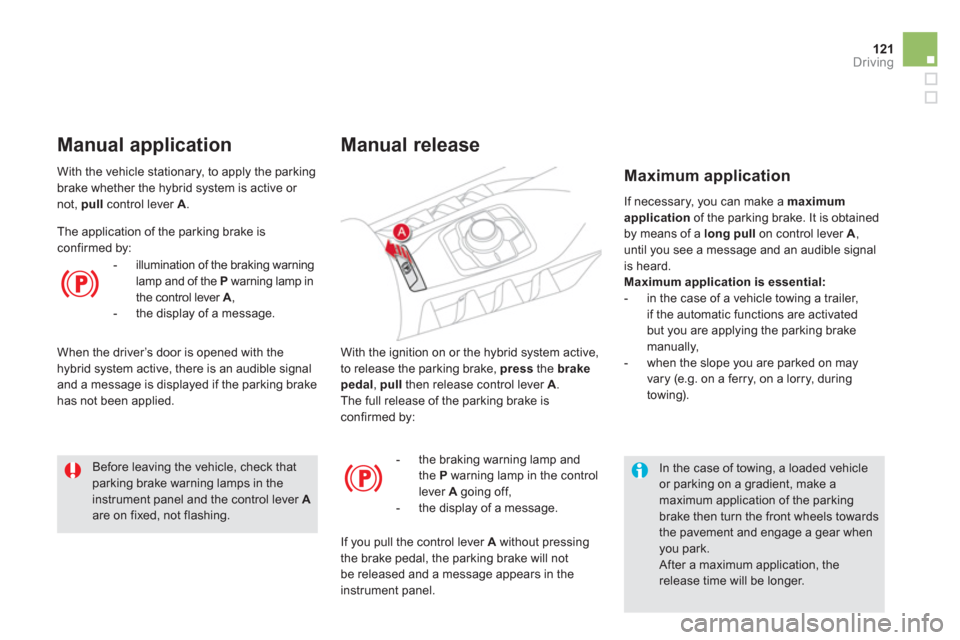
121Driving
With the ignition on or the hybrid system active,
to release the parking brake, press the brakepedal, pullthen release control lever A.The full release of the parking brake isconfirmed by:
Manual release
- the braking warning lamp and
the Pwarning lamp in the control lever A
going off,
- the display of a message.
I
f you pull the control lever A
without pressing
the brake pedal, the parking brake will not
be released and a message appears in the
instrument panel.
If necessar
y, you can make a maximum application
of the parking brake. It is obtained
by means of a long pull on control lever A ,
until you see a message and an audible signalis heard.
Maximum application is essential:
- in the case of a vehicle towing a trailer,
if the automatic functions are activated
but you are applying the parking brakemanually,
- when the slope you are parked on mayvary (e.g. on a ferry, on a lorry, duringtowing).
Maximum application
In the case of towing, a loaded vehicle or parking on a gradient, make amaximum application of the parkingbrake then turn the front wheels towardsthe pavement and engage a gear whenyou park.
After a maximum application, the release time will be longer.
Before leaving the vehicle, check that parking brake warning lamps in the instrument panel and the control lever Aare on fixed, not flashing. With the vehicle stationar
y, to apply the parkingbrake whether the hybrid system is active or not, pull
control lever A .
Manual application
The application of the parking brake is confirmed by:
- illumination of the brakin
g warning
lamp and of the P warning lamp in
the control lever A ,
- the display of a message.
When the driver
’s door is opened with the hybrid system active, there is an audible signal
and a message is displayed if the parking brakehas not been applied.
Page 124 of 358
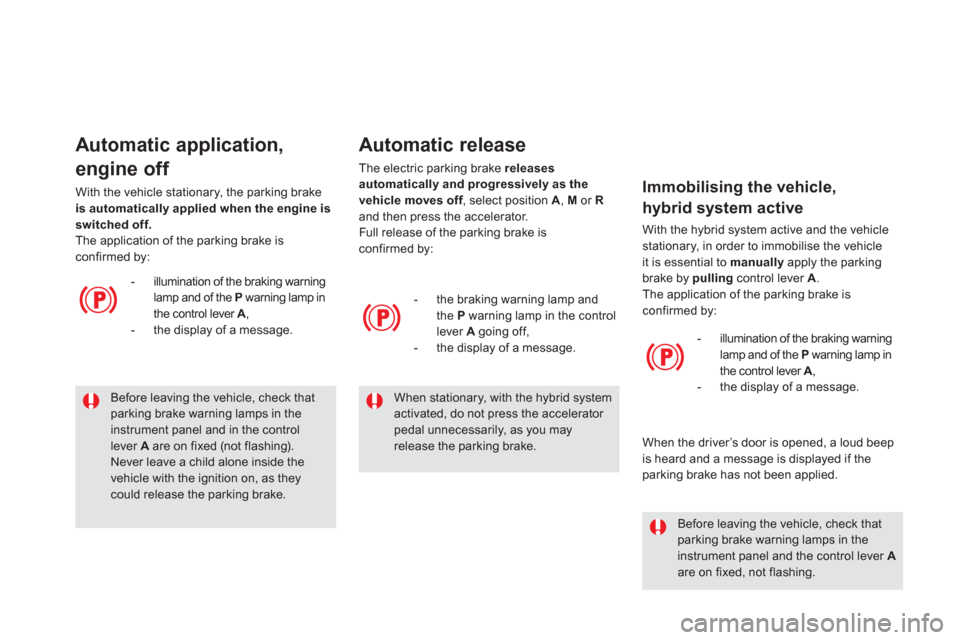
Before leaving the vehicle, check thatparking brake warning lamps in the instrument panel and in the control lever Aare on fixed (not flashing). Never leave a child alone inside thevehicle with the ignition on, as theycould release the parking brake.
Automatic application,
engine off
- illumination of the braking warninglamp and of the P
warning lamp in
the control lever A ,
- the display of a message. With the vehicle stationar
y, the parking brake is automatically applied when the engine is
switched off.The application of the parking brake is confirmed by:
Automatic release
The electric parking brake releases
automatically and progressively as thevehicle moves off, select position fA
, M
or Rand then press the accelerator.
Full release of the parking brake isconfirmed by:
- t
he braking warning lamp andthe P
warning lamp in the controllever A
going off,
- the display of a message.
When stationary, with the hybrid system activated, do not press the accelerator pedal unnecessarily, as you may release the parking brake.
Before leaving the vehicle, check that parking brake warning lamps in the instrument panel and the control lever Aare on fixed, not flashing.
Immobilising the vehicle,
h
ybrid system active
With the hybrid system active and the vehiclestationary, in order to immobilise the vehicleit is essential to manuallyapply the parking brake by pulling
control lever A.
The application of the parking brake is confirmed by:
- illumination of the brakin
g warning lamp and of the P
warning lamp in
the control lever A,
- the display of a message.
When the driver
’s door is opened, a loud beep
is heard and a message is displayed if the parking brake has not been applied.
Page 125 of 358
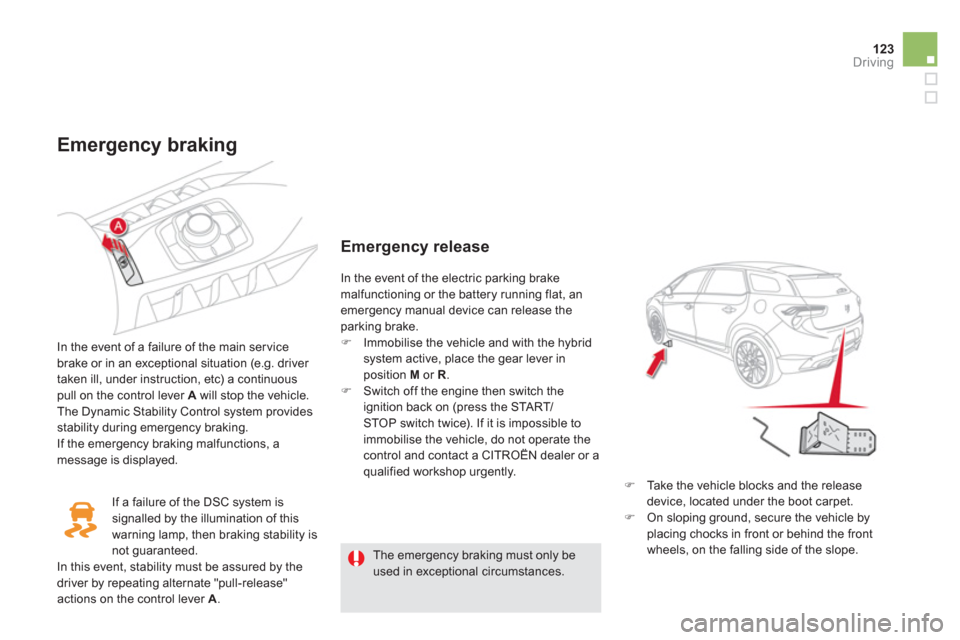
123Driving
Emergency braking
In the event of a failure of the main servicebrake or in an exceptional situation (e.g. driver
taken ill, under instruction, etc) a continuouspull on the control lever A will stop the vehicle.
The Dynamic Stability Control system provides stability during emergency braking.
If the emer
gency braking malfunctions, amessage is displayed.
Emergency release
�)
Ta k e the vehicle blocks and the release device, located under the boot carpet. �)
On sloping ground, secure the vehicle by
placing chocks in front or behind the front
wheels, on the falling side of the slope. In the event of the electric parkin
g brake
malfunctioning or the battery running flat, an
emergency manual device can release theparking brake. �) Immobilise the vehicle and with the hybridsystem active, place the gear lever in
position M or R
. �)
Switch off the engine then switch the
ignition back on (press the START/STOP switch twice). If it is impossible to immobilise the vehicle, do not operate the control and contact a CITROËN dealer or a qualified workshop urgently.
The emergency braking must only be used in exceptional circumstances. I
f a failure of the DSC system is
signalled by the illumination of this warning lamp, then braking stability isnot guaranteed.
In this event, stability must be assured by the
driver by repeating alternate "pull-release" actions on the control lever A.
Page 126 of 358
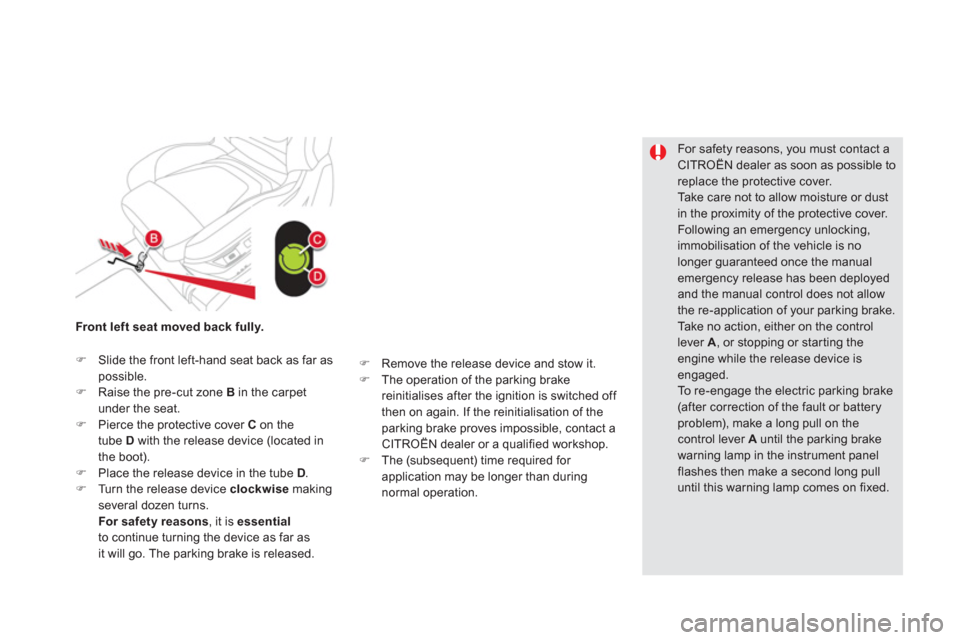
For safety reasons, you must contact a
CITROËN dealer as soon as possible to replace the protective cover. Ta k e care not to allow moisture or dust in the proximity of the protective cover.
Following an emergency unlocking, immobilisation of the vehicle is no longer guaranteed once the manualemergency release has been deployed and the manual control does not allow the re-application of your parking brake. Take no action, either on the controllever A, or stopping or star ting the engine while the release device is engaged.
To r e - e ngage the electric parking brake(after correction of the fault or battery problem), make a long pull on the control lever A
until the parking brake warning lamp in the instrument panel flashes then make a second long pulluntil this warning lamp comes on fixed. Front left seat moved back full
y.
�)Slide the front left-hand seat back as far aspossible. �)Raise the pre-cut zone B in the carpetunder the seat.�)Pierce the protective cover Con the
tube D with the release device (located in
the boot).�)Place the release device in the tube D.�)Turn the release device clockwisemaking several dozen turns.
For safety reasons, it is essential
to continue turning the device as far as it will go. The parking brake is released.
�)
Remove the release device and stow it. �)
The operation of the parking brake
reinitialises after the ignition is switched off
then on again. If the reinitialisation of the
parking brake proves impossible, contact a
CITROËN dealer or a qualified workshop.�) The (subsequent) time required for
application may be longer than during
normal operation.
Page 127 of 358
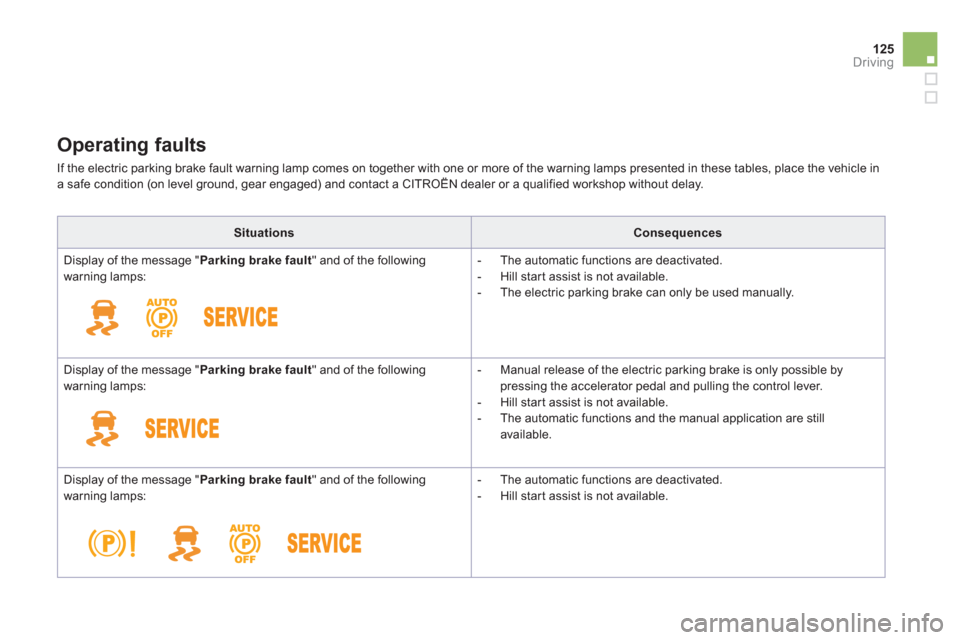
125
Driving
Operating faults
If the electric parking brake fault warning lamp comes on together with one or more of the warning lamps presented in these tables, place the vehicle in
a safe condition (on level ground, gear engaged) and contact a CITROËN dealer or a qualified workshop without delay.
SituationsConsequences
Display of the message "Parking brake fault" and of the following warning lamps:
- The automatic functions are deactivated.
- Hill start assist is not available.
- The electric parking brake can only be used manually.
Displa
y of the message "Parking brake fault" and of the following warning lamps:
- Manual release of the electric parking brake is only possible bypressing the accelerator pedal and pulling the control lever.
- Hill start assist is not available.
- The automatic functions and the manual application are still
available.
Displa
y of the message "Parking brake fault" and of the following warning lamps:
- The automatic functions are deactivated.
- Hill start assist is not available.
Page 128 of 358
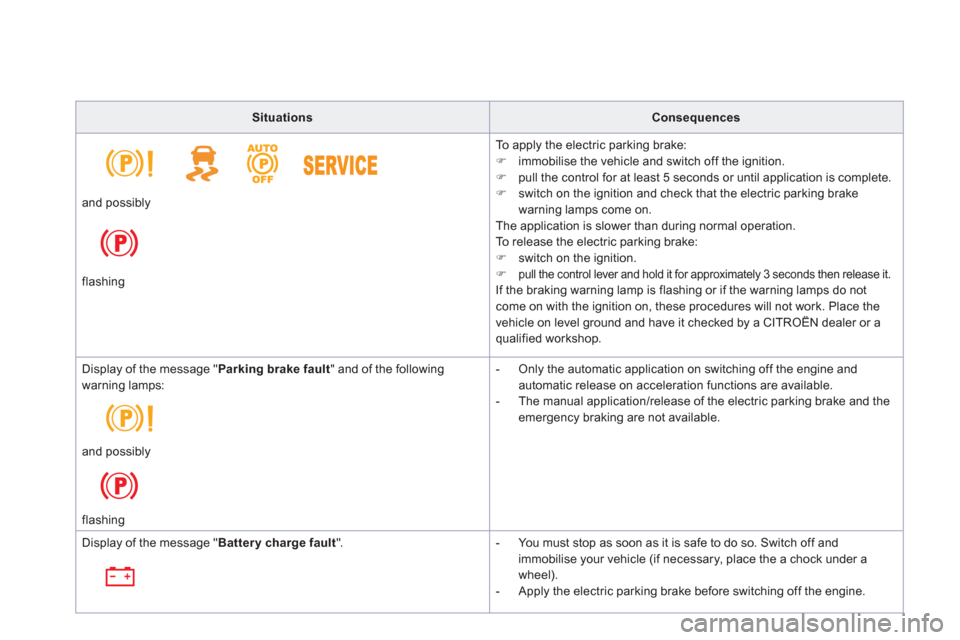
SituationsConsequences
To a p p l
y the electric parking brake:
�)
immobilise the vehicle and switch off the ignition. �)
pull the control for at least 5 seconds or until application is complete.�)
switch on the ignition and check that the electric parking brake
warning lamps come on.
The application is slower than during normal operation.
To release the electric parking brake:
�)
switch on the ignition.�)pull the control lever and hold it for approximately 3 seconds then release it.
If the braking warning lamp is flashing or if the warning lamps do not come on with the ignition on, these procedures will not work. Place the
vehicle on level ground and have it checked by a CITROËN dealer or a qualified workshop.
and possibl
y
flashing
Display of the message "Parking brake fault" and of the following
warning lamps:
- Only the automatic application on switching off the engine and automatic release on acceleration functions are available.
- The manual application/release of the electric parking brake and theemergency braking are not available.
an
d possibly
flashing
Display of the message "Battery charge fault".
- You must stop as soon as it is safe to do so. Switch off and
immobilise your vehicle (if necessary, place the a chock under a
wheel).
- Apply the electric parking brake before switching off the engine.
Page 129 of 358
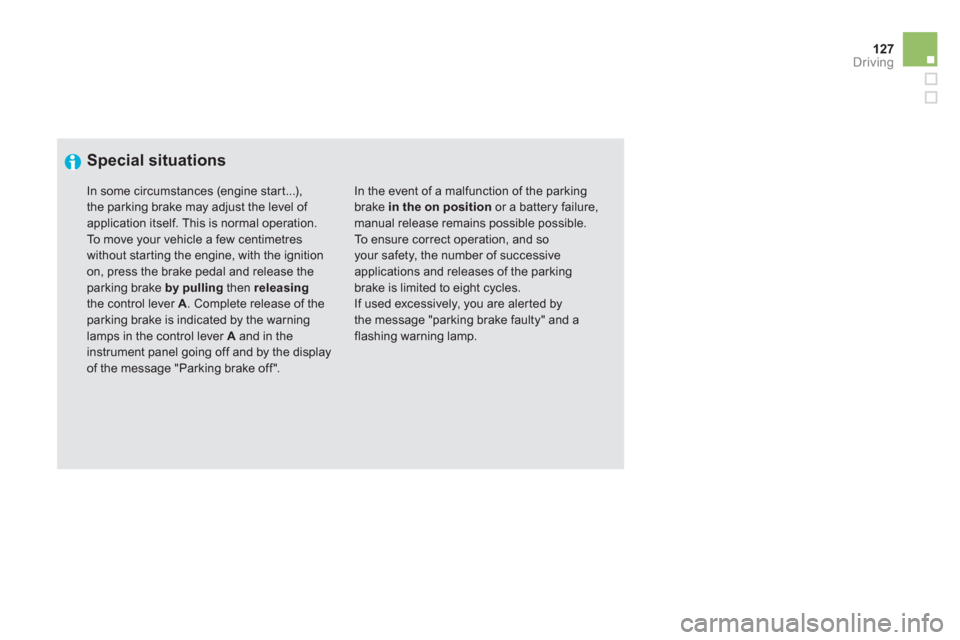
127Driving
Special situations
In the event of a malfunction of the parkingbrake in the on position
or a battery failure,manual release remains possible possible. To ensure correct operation, and soyour safety, the number of successive applications and releases of the parking brake is limited to eight cycles.
If used excessively, you are aler ted by the message "parking brake faulty" and aflashing warning lamp.
In some circumstances (engine start...),the parking brake may adjust the level of application itself. This is normal operation.
To m o v e your vehicle a few centimetres without starting the engine, with the ignitionon, press the brake pedal and release the parking brake by pullingthen releasingthe control lever A
. Complete release of theparking brake is indicated by the warninglamps in the control lever Aand in theinstrument panel going off and by the display of the message "Parking brake off".
Page 130 of 358
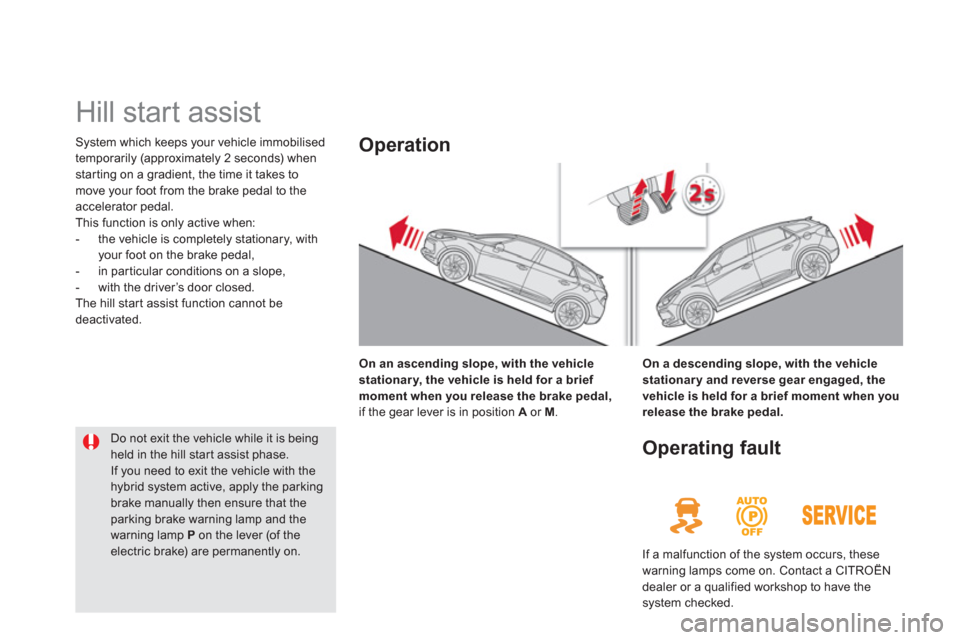
Hill start assist
System which keeps your vehicle immobilised
temporaril
y (approximately 2 seconds) whenstarting on a gradient, the time it takes to move your foot from the brake pedal to the accelerator pedal.
This function is only active when:
- t
he vehicle is completely stationary, withyour foot on the brake pedal,
- in particular conditions on a slope,
- with the driver’s door closed.
The hill start assist function cannot bedeactivated.
On an ascendin
g slope, with the vehiclestationary, the vehicle is held for a brief moment when you release the brake pedal,if the gear lever is in position A or M.
Operation
On a descending slope, with the vehicle
stationary and reverse gear engaged, thevehicle is held for a brief moment when you release the brake pedal.
Do not exit the vehicle while it is beingheld in the hill star t assist phase.
If you need to exit the vehicle with the hybrid system active, apply the parkingbrake manually then ensure that theparking brake warning lamp and thewarning lamp P
on the lever (of the electric brake) are permanently on.
Operating fault
If a malfunction of the system occurs, these
warning lamps come on. Contact a CITROËN
dealer or a qualified workshop to have the
system checked.
Page 133 of 358
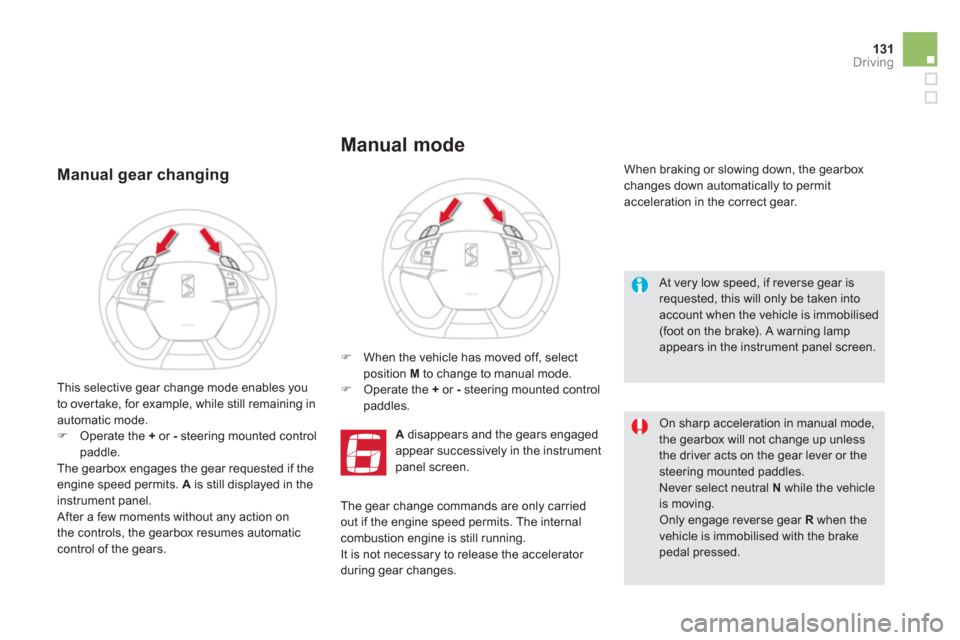
131Driving
Manual gear changing
�)
When the vehicle has moved off, selectposition M
to change to manual mode. �)
Operate the +or -steering mounted control
paddles.
Adisappears and the gears engaged
appear successively in the instrument
panel screen.
When braking or slowing down, the gearbox changes down automatically to permit
acceleration in the correct gear.
This selective
gear change mode enables you
to over take, for example, while still remaining in automatic mode.�)Operate the + or -
steering mounted controlpaddle.
The gearbox engages the gear requested if the engine speed permits. A
is still displayed in theinstrument panel.
After a few moments without any action on
the controls, the gearbox resumes automaticcontrol of the gears.
Manual mode
At very low speed, if reverse gear is requested, this will only be taken intoaccount when the vehicle is immobilised(foot on the brake). A warning lamp appears in the instrument panel screen.
On sharp acceleration in manual mode,
the gearbox will not change up unless the driver acts on the gear lever or thesteering mounted paddles.
Never select neutral N
while the vehicleis moving. Only engage reverse gear Rwhen thevehicle is immobilised with the brake pedal pressed.
The gear change commands are only carriedout if the engine speed permits. The internal combustion engine is still running.
It is not necessary to release the accelerator
during gear changes.
Page 134 of 358
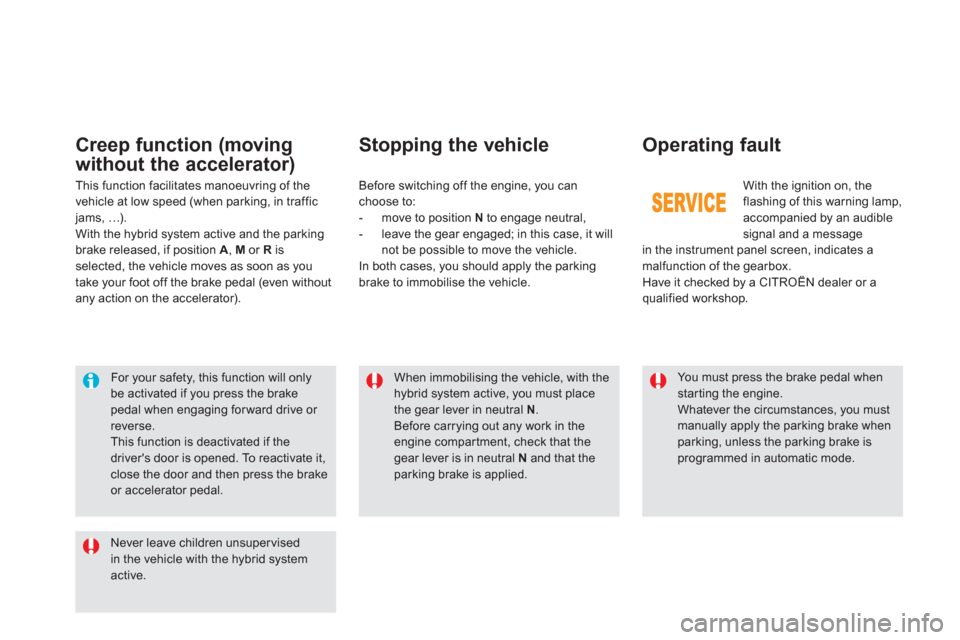
When immobilising the vehicle, with the hybrid system active, you must place the gear lever in neutral N.Before carrying out any work in the
engine compar tment, check that the gear lever is in neutral N and that the parking brake is applied.
Stopping the vehicle
With the ignition on, the flashing of this warning lamp,
accompanied by an audible
signal and a message
in the instrument panel screen, indicates a
malfunction of the gearbox.
Have it checked by a CITROËN dealer or a qualified workshop. Be
fore switching off the engine, you can choose to:
- move to position N
to engage neutral,
- leave the gear engaged; in this case, it will
not be possible to move the vehicle.
In both cases, you should apply the parkingbrake to immobilise the vehicle.
Operating fault
You must press the brake pedal when star ting the engine.
Whatever the circumstances, you must manually apply the parking brake when
parking, unless the parking brake isprogrammed in automatic mode.
Never leave children unsupervised in the vehicle with the hybrid system active.
For your safety, this function will only be activated if you press the brakepedal when engaging for ward drive or reverse.
This function is deactivated if thedriver's door is opened. To reactivate it, close the door and then press the brake or accelerator pedal.
Creep function (moving
without the accelerator
)
This function facilitates manoeuvring of the
vehicle at low speed (when parking, in traffic jams, …).
With the hybrid system active and the parking
brake released, if position A, M or R
is selected, the vehicle moves as soon as you
take your foot off the brake pedal (even without any action on the accelerator).